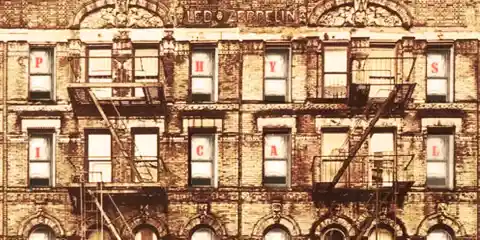

Led Zeppelin are credited with creating heavy metal, however, the quartet of Jimmy Page, Robert Plant, John Bonham and John Paul Jones were never really a metal band. Immersed in the blues, the band’s first two records were blues heavy as they covered Willie Dixon’s “You Shook Me” and “I Can’t Quit You Babe” on their debut. The blues-inspired music continued on their second release with reworked versions of Dixon’s “Whole Lotta Love” and “Bring it on Home.” By the time the band released their third album, they had proven to Atlantic Records that they could move product and were given a license to kill. It is hard to believe that their sixth album, Physical Graffiti, was released over 40 years ago.
Recorded at Headley Grange, Physical Graffiti was Zeppelin’s most ambitious record to date. The double album covered a lot of ground as the group experimented with new sounds. The recording was comprised of 8 originals and outtakes from previous sessions. They kept tunes hidden away from as far back as Led Zeppelin Ill, three from the from their fourth effort and three from Houses of the Holy, including the abandoned title track.
The record kicks off with rambunctious “Custard Pie” which oozes sexuality as the band pays respect to blues legend Elmore James. Jimmy uses a wah-wah peddle during the solo, Jones plays an electric clavinet for a groovy new affect and Plant wails on harmonica. This monster of a tune is is followed by the equally impressive track, “The Rover,” on which Jimmy used an echo effect using a phase shifter while Bonham wails on his drum kit. The group beefs things up a bit more on the seminal track, “Kashmir.” The song took three years to complete and the complexity of the masterpiece is evidence as they utilize an orchestral back drop among middle eastern influences.
“In The Light” was another departure for the band as it commences with John Paul Jones playing an ominous intro on the synthesizers before the band kicks into high gear. While it was written in 1971, “Down By The Seaside” didn’t see the light of day until 1975. Again, Page took full advantage of unlimited studio time to give the track special guitar attention.
“The Wanton Song” is about sex, no questions about it. Page uses a Jimi Hendrix trick on the track as he runs his guitar through a Leslie speaker and uses backwards echo on his solo. Originally recorded in 1971, “Boogie With Stu” has a jam band feel as former Rolling Stone Ian Stewart lends a funky piano riff to the song. The record closes with Plant’s homage to groupies, “Sick Again.” The track was a somewhat intense slam of the girls who hang out outside the hotel after a live performance.
Physical Graffiti, in my opinion, was Led Zeppelin’s last great record. What followed was the overwhelming Presence, the over-produced In Through the Out Door and the post-Bonham-death Coda, which was a mishmash of outtakes. They should have quit while they were ahead.